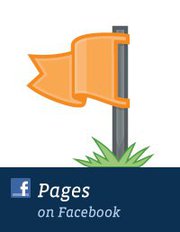facebook fan pages
A fan page lets you grow as big as you want, send updates to an unlimited number of people, and keep the focus on the organization without revealing the administrator (unless you want to).
Okay, so once you’ve set up your account as a fan page, then what? Here are some tips:
Upload a logo or photo with a web address at the bottom.
It won’t be clickable, but fans can see where to go if they want to visit your website.
Fill out your info page completely.
Here you can have a clickable web address, company overview, mission, and products. You can give only what Facebook asks for or get creative and provide other information as well.
For example, in your company overview, you can list links to pages on your website, your newsletter signup form, other social media, or whatever you want.
Use FBML to create a landing page.
FBML is Facebook’s version of HTML, which you can use with an application called Static FBML. This lets you render basic HTML in a box or tab on your page. You won’t find it in your default applications, but you can find it with a search in the application directory.
The idea is that instead of sending people to your wall, as most people do, you send them to a landing page with whatever message you want to provide. For example, you can give a short description of your organization and tell people to click the “become a fan” button.
This is one of those “duh” things you may not think about at first, but which can dramatically increase your Facebook growth. A landing page is just good direct marketing.
Use your tabs wisely.
If you think of a Facebook page as a secondary website for your business, you’ll realize that the tabs at the top of the page are like site navigation. You can have a tab for your newsletter, a tab for donations, a tab for products, etc. How? With that nifty FBML application.
Don’t forget the sidebar.
Anything you can put in your tabs, you can also put in your sidebar. A newsletter signup form fits here nicely. So does a poll (another application you can add), affiliate banner, or set of links.
Post often.
The same rules apply to Facebook as any other social media. It’s all about content and interaction. Posting something every few weeks won’t cut it. Post every day or even several times a day to make sure you’re showing up in the news feeds of your fans. This can be links to your blog, product announcements, questions, news items, or anything your fans would be interested in.
Every time someone becomes a fan, comments, clicks the “like” link, or shares your post, it shows up in that fan’s news feed for all their friends to see. So “viral” is built in.
Link to your page from everywhere.
If you want fans, you have to let people know you’re on Facebook. Put an icon or link in your newsletter, on your website or blog, in your email footer, everywhere.
Email and blog it.
Don’t be shy. Do an email blast driving subscribers to your fan page. Post a blog about what’s happening on your fan page with an invitation to become a fan.
Send updates to your fans.
This feature is a little like email. Don’t abuse it, because Facebook fans aren’t expecting (and don’t want) an avalanche of messages from you. But used wisely, this handy feature lets you update fans about your products, sales, and events.
Subscribe to similar fan pages and groups.
You can buy ads on Facebook, but the consensus is that response is poor. A cheap way to reach beyond your fans and attract new fans is to subscribe to similar pages and groups and post short messages inviting people to visit your page. Don’t do it too often. And don’t be spammy.
There’s more you can do with Facebook, but this is plenty to get you started.
Is it worth it? Absolutely. I’ve found that Facebook can drive significant traffic to your website as your fan base grows. And it gives you a totally independent way to interact with potential customers or supporters.
Referance: directcreative.com








0Awesome Comments!